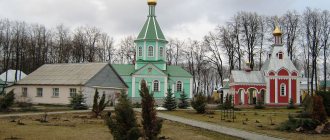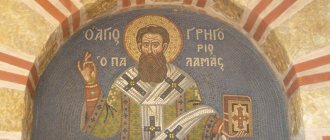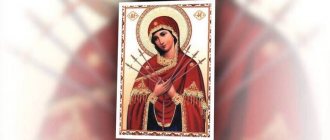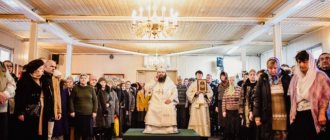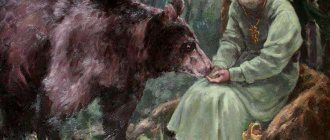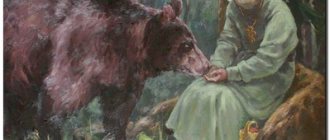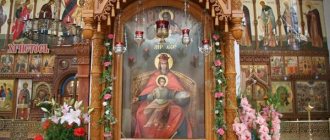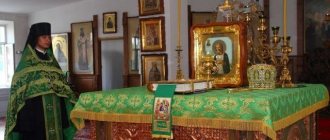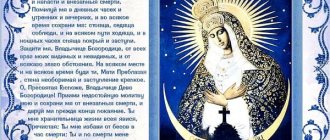To understand what patron Seraphim of Sarov is, you need, first of all, to know his life, what he did and what mark he left on history.
Born in the city of Kursk into a family of ordinary workers. At birth he received the name Prokhor. Since childhood, the boy was accustomed to physical labor. My parents were building a church.
Even in childhood, strange things happened to the child. For example, once a boy climbed a church bell tower and fell from it to the ground. The height was great, but the boy survived and remained virtually unharmed. He had no broken bones or serious wounds, just minor bruises.
After this incident, Prokhor realized that this was a sign from God and began to become interested in religion. Growing up, he wanted to devote himself to serving the Lord. In the Saratov region, he began to work as a priest and received the name Seraphim.
Seraphim of Sarov is canonized. According to legend, he had the gift of healing, so many people turned to him for help. According to legend, he could cure fatal diseases of internal organs.
He is revered in the Orthodox and Catholic religions.
Seraphim of Sarov is the patron saint of helping those in need. Even during his lifetime, people turned to him with a request to free his mind from sorrow, despondency or temptation. People pray to him in a state of despair and resentment. They ask for spiritual peace and satisfaction.
Iconography
The icon of Seraphim of Sarov is of great value for Orthodox people. With her, unimaginable and long-awaited miracles are constantly performed, and help is provided in various aspects of life. People turn to the saint in all situations, asking not only for themselves, but also for their family and loved ones.
While the great elder was still alive, his portrait was created. Now it is kept in America in the New Diveevo monastery.
In the iconographic image, the elder is depicted at an age younger than his years. His face is thin, his hair is combed back, his beard is smooth and flowing. The monk's gaze is calm, confident, self-absorbed, his eyes look straight into the heart of the person praying. The appearance of the elder expresses kindness, peace, mercy and humility.
There are 4 main iconographic images of Seraphim of Sarov:
- his hands are prayerfully folded crosswise at his heart: his right hand rests on top of his left hand;
- blessing gesture: the right hand blesses, and the left holds a rosary for prayer (an indispensable attribute of monks);
- kneeling prayer on a stone (a feat of standing that lasted 1000 days), the hands of the saint are raised to Heaven;
- image of an old man with a staff.
Advice! You can pray to the elder both in church and at home. Light a candle and read a prayer, and the God-bearing elder will fulfill your request!
Icon of Seraphim of Sarov
LiveInternetLiveInternet
Venerable Seraphim of Sarov. Seraphim of Sarov (in the world Prokhor Isidorovich Moshnin, in some sources - Mashnin;
July 19 (30), 1754 (or 1759), Kursk - January 2 (14), 1833, Sarov Monastery) - hieromonk of the Sarov Monastery, founder and patron of the Diveyevo convent.
Glorified by the Russian Church in 1903 as a saint on the initiative of Tsar Nicholas II.
One of the most revered Orthodox saints.
Popular veneration of the Sarov elder far outstripped his official canonization.
Because of this, many images of the elder dispersed throughout Russia, like fragments of the stone on which he prayed - long before the appearance of canonical icons.
The monk himself reluctantly agreed to pose, saying: “Who am I, poor thing, to paint my appearance from me?”
Seraphim of Sarov with his life (icon, early 20th century).
Born in 1754 in Kursk, in the family of a wealthy eminent merchant Isidor Moshnin and his wife Agathia. I lost my father very early. At the age of 7, he fell from the bell tower of the Sergius-Kazan Cathedral under construction on the site of the previously burned down Church of St. Sergius of Radonezh, but remained unharmed.
At a young age, Prokhor became seriously ill. During his illness, he saw the Mother of God in a dream, promising to heal him. The dream turned out to be true: during the procession of the Cross, an icon of the Sign of the Most Holy Theotokos was carried past his house, and his mother brought Prokhor out to venerate the icon, after which he recovered.
Painting by priest Sergius Simakov. Prokhor Moshnin falls from the bell tower. In 1776, he made a pilgrimage to Kyiv to the Kiev-Pechersk Lavra, where Elder Dosifei blessed and showed him the place where he was to accept obedience and take monastic vows - the Sarov Hermitage. In 1778 he became a novice under Elder Joseph at the Sarov Monastery in the Tambov province. In 1786 he became a monk and was ordained a hierodeacon; in 1793 he was ordained a hieromonk.
Venerable Seraphim of Sarov. Unknown artist, 1860s – 1870s. Kept in the Church-Archaeological Cabinet of the Moscow Theological Academy. In this portrait, St. Seraphim is depicted as relatively young. In 1794, having a penchant for solitude, he began to live in the forest in a cell five kilometers from the monastery. As part of ascetic deeds and exercises, he wore the same clothes in winter and summer, got his own food in the forest, slept little, fasted strictly, re-read holy books (the Gospel, patristic writings), and prayed for a long time every day. Near the cell, Seraphim planted a vegetable garden and built a beekeeper.
In the 19th century, several scenes from the life of the monk arose, which were repeated in a variety of lithographs and popular prints. One of them is “Standing on a Stone.”
A number of facts from the life of St. Seraphim is quite remarkable. Once, for three and a half years, an ascetic ate only grass. Later, Seraphim spent a thousand days and a thousand nights in the feat of pillar-building on a stone boulder.
Some of those who came to him for spiritual advice saw a huge bear, which the monk fed with bread from his hands (according to Father Seraphim himself, this bear constantly came to him, but it is known that the Elder also fed other animals).
Unknown artist. Venerable Seraphim of Sarov.
St. Seraphim feeds a bear. Miniature in copper enamel technique of the early 20th century, Rostov. Stored in the Central Accreditation Center of the MDA.
Venerable Seraphim of Sarov feeding a bear. 1879 Workshop of the Seraphim-Diveevo Monastery. E. Petrova. Lithography. RSL Of the more dramatic events, the case of the robbers is known. According to the life, some robbers, having learned that rich visitors often came to Seraphim, decided to rob his cell.
Finding him in the forest during daily prayer, they beat him and broke his head with the butt of an ax, and the saint did not resist, despite the fact that he was a young and strong man at that time.
The robbers found nothing for themselves in his cell and left.
The monk miraculously returned to life, but after this incident he remained severely hunched over forever. Later these people were caught and identified, but Father Seraphim forgave them; at his request they were left without punishment.
In 1807, the monk took upon himself the monastic feat of silence, trying not to meet or communicate with anyone. In 1810 he returned to the monastery, but went into seclusion until 1825.
After the end of the retreat, he received many visitors from monastics and lay people, having, as it is said in his life, the gift of clairvoyance and healing from illnesses. Notable people also visited him, including Tsar Alexander I.
He addressed everyone who came to him with the words “My joy!”, and greeted everyone at any time of the year with the words “Christ is risen!”
M. Maimon. Reverend Seraphim of Sarov and Emperor Alexander I. 1904 Was the founder and permanent patron of the Diveyevo women's monastery. In 1831, the saint was granted a vision of the Mother of God (for the twelfth time in his life) surrounded by John the Baptist, John the Theologian and 12 virgins. He died in 1833 in the Sarov Monastery in his cell during kneeling prayer.
Venerable Seraphim of Sarov. XIX century. Kept in the Church-Archaeological Cabinet of the Moscow Theological Academy. A picturesque portrait by an unknown artist. Probably a copy of a lifetime portrait.
Venerable Seraphim of Sarov. 1840 Lithography. ISO RSL. One of the first lithographic images of the saint. Probably the lithograph reproduces a lifetime portrait of an old man, where he is represented walking into the “small hermitage.” The first “Tale of the Life and Deeds” of Elder Seraphim was published in 1841 in Moscow, signed by IC. In 1844, in the XVI volume of the Mayak magazine, a more detailed legend about Elder Seraphim was published - its author was not identified, but Moscow Metropolitan Philaret in a letter to Archimandrite Anthony attributed this work to a certain George (probably the abbot of the Nikolo-Barkovskaya hermitage, who lived under Father Seraphim as a guest in Sarov under the name Guria; in 1845 this legend was published as a separate book in St. Petersburg.
Saida Munirovna Afonina. Prayer for the gift of a source. Venerable Seraphim of Sarov. in 1863, at the request of the Sarov Monastery - according to its archival documents and eyewitness accounts, the most complete depiction of the life and exploits of Elder Seraphim was published; the author of this work, N.V. Elagin, was indicated only in the 5th edition, in 1905.
Available memoirs about Seraphim of Sarov and collections of his statements clearly describe the elder as a supporter of the official church, hierarchy and the three-fingered sign of the cross.
Painting by priest Sergius Simakov. Get back from where you came. (Seraphim of Sarov drives out the Mason). Seraphim of Sarov did not leave any written works behind him at all.
V.E. Raev. Venerable Seraphim of Sarov. 1830s. Sayings attributed to Seraphim of Sarov : Take away sin, and illnesses will go away, for they are given to us for sins. And you can overeat yourself with bread. You can receive communion on earth and remain uncommunicated in Heaven. Whoever endures an illness with patience and gratitude is credited with it instead of a feat or even more. No one has ever complained about bread and water. Buy a broom, buy a broom, and sweep your cell more often, because as your cell is swept, so will your soul be swept. More than fasting and prayer is obedience, that is, work.
Yu.I. Peshekhonov. St. Seraphim of Sarov. There is nothing worse than sin, and nothing more terrible and destructive than the spirit of despondency. True faith cannot be without works: whoever truly believes certainly has works. If a person knew what the Lord had prepared for him in the Kingdom of Heaven, he would be ready to sit in a pit of worms all his life. Humility can conquer the whole world.
You need to remove despondency from yourself and try to have a joyful spirit, not a sad one. Out of joy a person can do anything, out of inner stress - nothing. An abbot (and even more so a bishop) must have not only a fatherly, but even a motherly heart. The world lies in evil, we must know about it, remember it, overcome it as much as possible.
Let there be thousands of those living in the world with you, but reveal your secret to one out of a thousand. If the family is destroyed, then states will be overthrown and nations will be corrupted. As I forge iron, so I have handed over myself and my will to the Lord God: as He pleases, so I act; I don’t have my own will, but what God pleases, that’s what I convey.
View of the Holy Trinity Seraphim-Diveevo Convent. Lithography. Many of the now famous teachings of Elder Seraphim were drawn from the notes of the landowner Nikolai Aleksandrovich Motovilov, allegedly found by S. A. Nilus and published by him in 1903.
S. Ivleva. Conversation between St. Seraphim of Sarov and N.A. Motovilov. 2010 Popular veneration of “Father Seraphim” began long before his canonization, during his lifetime. Preparations for the official canonization caused a political scandal.
Sergiy Simakov. Seraphim of Sarov blesses the family of Nicholas II.
According to Count S. Yu. Witte, Nicholas II personally demanded canonization from Pobedonostsev, apparently at the insistence of his wife, in the spring of 1902 (according to the official version, July 19, 1902). Count Witte also wrote about the role of Alexandra Feodorovna: “<…> They say that they were sure that the Sarov saint would give Russia an heir after four Grand Duchesses. This came true and finally and unconditionally strengthened the faith of Their Majesties in the holiness of the truly pure Elder Seraphim. A large portrait appeared in His Majesty’s office - the image of St. Seraphim.”
Icon embroidered by the daughters of Tsar Nicholas II. Venerable Seraphim of Sarov praying on a stone. Beginning of the 20th century. Sewing. Ioannovsky Monastery on Karpovka. Saint Petersburg. Signature: “This holy image is embroidered by the hands of the Grand Duchesses Olga, Tatiana, Maria and Anastasia.”
On January 11, 1903, a commission chaired by Metropolitan Vladimir (Bogoyavlensky) of Moscow, which included Archimandrite Seraphim (Chichagov), examined the remains of Seraphim Moshnin. The results of the examination were presented in a secret, all-submissive report, which, however, soon became widely known to the reading public.
Since there were expectations of the “incorruptibility” of the relics, which was not discovered, Metropolitan Anthony (Vadkovsky) of St. Petersburg had to make a statement in “New Time” and in “Additions to the Church Gazette”, where he stated the fact of the preservation of the “skeleton” of the Sarov elder and expressed his opinion that the presence of incorruptible relics is not necessary for glorification.
The coffin-deck in which Father Seraphim was buried. With its Act of January 29, 1903, the Holy Synod announced: “The Holy Synod, in full conviction of the truth and reliability of the miracles performed through the prayers of Elder Seraphim, having given praise to the wondrous Lord God in His saints, who has ever blessed the Russian State, strong in forefathers’ Orthodoxy, and now , during the days of the blessed reign of the Most Pious Sovereign Emperor Nikolai Alexandrovich, as of old, who was pleased to show by the glorification of this piety of the ascetic a new and great sign of His benefits to the Russian Orthodox people, presented His all-subject report to His Imperial Majesty, in which he set out the following decision: 1) the reverent elder Seraphim , resting in the Sarov desert, recognize as a saint, glorified by the grace of God, and his most honorable remains as holy relics and place them in a tomb especially prepared by the zeal of His Imperial Majesty for worship and honor from those who come to him with prayer, 2) service to the Reverend Father Seraphim draw up a special one, and before the time of drawing up one, after the day of glorifying his memory, send him a common service to the monks, celebrate his memory both on the day of his repose, January 2, and on the day of the opening of his holy relics, and 3) announce this on national news from the Holy Synod." In the summer of 1903, the “Sarov Celebrations” took place with a huge crowd of people and with the participation of the Tsar and other members of the imperial family.
Transfer of the holy relics of St. Seraphim of Sarov to the Assumption Cathedral of the Sarov Hermitage on July 18, 1903. Workshop of E. I. Fesenko. Odessa. Chromolithograph. ISO RSL.
Procession of the cross in the Sarov Monastery with the holy relics of St. Seraphim of Sarov. July 19, 1903 Workshop of the Seraphim-Diveevsky Monastery. Museum at the Church of St. Mitrophan of Voronezh. Moscow.
Canonization of St. Seraphim of Sarov. Rev. Seraphim is widely revered among Orthodox believers even today. Miracles and healings were repeatedly reported at his relics, as well as appearances to his people (for example, St. John of Kronstadt writes about one of them in his book).
Pavel Ryzhenko. Seraphim of Sarov. In November 1920, the IX District Congress of Soviets, held in Temnikov, decided to open the shrine containing the remains of St. Seraphim of Sarov. The speaker who demanded the opening of the relics was the famous Mordovian poet, translator of the “International” into the Moksha language Z. F. Dorofeev. On December 17, 1920, the relics were opened and a report was drawn up.
In 1922, the relics were seized and transported to Moscow, to the Museum of Religious Art in the Donskoy Monastery. And in the church in honor of St. Seraphim, consecrated in 1914 in the Donskoy Monastery, one of the first crematoria in the USSR was built in 1927 (this crematorium was also called the “department of atheism”).
It is worth noting that the icon of Seraphim of Sarov was painted from his lifetime portrait made by the artist Serebryakov (later monk Joseph of the Sarov monastery) 5 years before the death of the elder. In the fall of 1990, unknown remains were found in the storerooms of the Museum of the History of Religion (in the Kazan Cathedral) in Leningrad. according to the description.
In December 1990, the remains were examined by a commission consisting of Bishop Evgeniy (Zhdan) of Tambov and Bishop Arseniy (Epifanov); The commission, guided by the act of examining the remains of Fr. Seraphim in 1902 and by the act of opening the relics, established that the remains were the relics of St. Seraphim of Sarov.
On January 11, 1991, the transfer of the relics took place; On February 6-7, 1991, with the participation of Patriarch Alexy II, the relics were delivered to Moscow from the Trinity Cathedral of the Alexander Nevsky Lavra and transferred in a procession to the Epiphany Cathedral.
On July 28, 1991, a religious procession with the relics left Moscow, and on August 1, 1991, with a large crowd of people, the saint was greeted at the Diveyevo Monastery. On July 17, 2006, the Holy Synod decided to open the Assumption Sarov Hermitage.
From July 29 to July 31, 2007, celebrations dedicated to the Day of Remembrance of St. Seraphim of Sarov were held in the village of Diveevo, Nizhny Novgorod region.
They were visited by over 30,000 pilgrims.
In 1991, the famous sculptor Vyacheslav Klykov made and presented to the city of Sarov a monument to St. Seraphim of Sarov. The monument was erected in the Far Hermitage area, in the forest. In September 2007, a prayer service was held for the first time by St. Seraphim as the patron saint of nuclear scientists. In 2011, a street in Batajnica, a suburb of Belgrade (Serbia), was named after Seraphim of Sarov; Previously, the street named after the saint was called “Partisan Bases”.
In August 2011, a monument to the Holy Father the Wonderworker was consecrated in Yekaterinburg.
Monument to Seraphim of Sarov in the Kursk Root Hermitage.
source
What do they pray for in front of the icon of the miracle worker?
Even during his earthly life, the people revered Father Seraphim as a saint. Immediately after his death, many prayers, akathists, and glorifications were written, although the miracle worker had not yet been canonized. People simply believed in his holiness and expected quick glorification.
Before the face of Elder Seraphim they pray:
- in moments of despair, sorrow and despondency;
- for protection from temptations;
- to guide those who have stumbled on the right path;
- for the sake of solving various everyday problems;
- for the healing of the spiritually and physically sick;
- about granting help to the penitent;
- about help in a successful marriage;
- about the long-awaited conception of a child;
- in difficult childbirth;
- about mending failed family relationships;
- about finding love and harmony between spouses;
- about assistance in business and trade:
- about supporting good causes.
Read about the saint:
- Seraphim-Diveevo Monastery
- Akathist to St. Seraphim of Sarov
- The relics of the monk
Important!
When turning to Father Seraphim in prayer, you should remember that he, like other saints, does not specialize in helping in any specific matters. When turning to him with faith in the Power of God, and not in the power of the icon, the prayer book always receives what he asks for. When turning to a saint, you must have pure thoughts and an open soul. Otherwise, selfishness will become a terrible obstacle, and the prayer will not be fulfilled.
Facts about the saint
The life of the reverend was quite different from the lives of most other people from early childhood. Here are the most interesting facts known to historians about the ascetic:
- As a child, he fell from a bell tower, but remained unharmed.
- As a child, I suffered from dropsy for three years, of which I did not get out of bed for one and a half years. He was healed after communion and the appearance of the Most Pure Virgin.
- He lived as a hermit for 47 years.
- Spent a thousand days praying on a stone.
- Hand fed the bears.
- The cell icon of the monk is the “Tenderness” of the Most Holy Theotokos.
- He was glorified 70 years after his earthly death - in 1903.
The earthly life of an ascetic is worthy of the attention of every Orthodox believer. The exploits of the righteous man do not lose their relevance even almost two centuries after their commission. Therefore, we recommend that you familiarize yourself with the life of the saint in more detail, if you have not already done so.
Days of remembrance - January 15, August 1. However, you can pray to the monk on any day of the year. It’s just that on the day of celebration you should pray to Saint Seraphim strictly.
Which churches have miraculous icons of Father Seraphim
- Danilov Monastery - part of the holy relics and two miraculous lists;
- Elokhovsky Epiphany Cathedral - a miraculous image with particles of stone on which the saint performed the feat of standing;
- Seraphim Cemetery in Old Peterhof - a miraculous face;
- Church of the Resurrection of Christ (Narva, Estonia) - a miraculous image.
Icon of Seraphim of Sarov
Why do you dream about the icon of Seraphim of Sarov?
In all religions, the icon is a symbol of the highest spiritual power. Before you start interpreting a dream with an icon, you need to remember several things: firstly, how the icon appeared in the dream (standing on the table, falling to the ground, being held in your arms, etc.), secondly, who was depicted on the icon.
The second point is more important, since every saint is a patron of one or another cause. Interpretation becomes more difficult if a person does not remember the image or does not know who was depicted.
Unfortunately, the image of Seraphim of Sarov in dreams does not bring good news. The saint warns that failure and misfortune will soon overtake a person. However, we must not give up. You have to try to solve the problem yourself. You should turn to God for help, not to close friends. In this case, the bad moments will pass faster, and everything will get better in life.
There is no need to rely only on divine help. Only with his own hands can a person pave his way to a bright future. The prayer to the icon of Seraphim of Sarov warns a person not to make hasty conclusions and rash actions (other icons also warn about this).
Holy relics
The relics of the saint rest within the walls of the Sarov Monastery, located in the Nizhny Novgorod region.
You can venerate a particle of the relics in the Church of St. George the Victorious in Endov, which houses the Compound of the Spaso-Preobrazhensky Solovetsky Stauropegial Monastery.
Advice! Priests advise that while standing in a long-hour line to see the relics, not just stand, but pray to the elder. He sees and hears everything! Saint Seraphim commanded to pray to him as if he were alive, then he too will be alive for all prayer books.
In prayer you should remember the names of all loved ones and relatives. It is advisable to ask the seraphim’s intercession before the Lord for admonition, for the granting of consolation in problems.
When the turn comes to the relics, it is necessary to make two bows before them and after each apply the Sign of the Cross. When approaching the shrine, you first need to kiss it (attach your lips), and only then touch it with your forehead. Then you should bow and cross yourself. If you need to consecrate an icon on the relics of a saint, then it is better to give it to the nun sister standing at the head of the relics. She will apply it to the shrine, and the image will become consecrated. You can consecrate Orthodox crosses, the “Alive in Help” belt, icons, and rosaries.
Read about Christian paraphernalia:
- What is an amulet and how is it worn?
- Why wear a cross (conversations with children)
- Why do we need rosary beads?
Praying on a stone:
When Seraphim of Sarov became a monk, he built a living cell not far from the monastery. I was looking for food for myself: it was mainly pine and other herbs. For some time I grew vegetables, raised bees and made bread with my own hands. Animals came to him and literally ate from his hands: this was also captured by artists. At the same time of his hermitage, Seraphim took a vow of continuous prayer, which lasted 1000 days and nights. To do this, he chose a huge stone for prostrations, and hung an icon with the image of the Virgin Mary on a tree near the stone. This image in the iconography of Seraphim of Sarov is also very popular among believers, as a sign of zealous faith in God’s power.
After fulfilling his vow of 1000 days, Seraphim of Sarov, with even greater strength and perseverance, decided to surrender into the hands of God. He hardly ate and took a vow of silence for several years. All the time he prayed continuously. And after a vow of silence, he completely became a hermit. Reclusion strengthened his own and people’s faith in his insight and ability to heal. People came to him and asked him to bless him and guide him on the right path. He predicted the future, and before his death he ordered to turn in prayer as if he were alive.
For this reason, you can still find in people’s homes an icon with Seraphim of Sarov, who, as if alive, lives in the house and helps people find peace and faith.
Nuances of correct prayer
An Orthodox person needs prayer to see his sins. And in order for the Lord and the saints to hear the prayer, certain conditions must be met:
- Attention. It is necessary to focus on prayer, be attentive to your thoughts and spoken words. This is work. Mechanically reading prayers without comprehension is a dangerous activity; it is easy to get used to it, and as a result, the prayer itself will be forgotten and it is possible to show pride in one’s “prayerfulness.”
- Repentance. It must come from the depths of the soul, and the desire to improve your life must be sincere and sincere.
- Humility and reverence. Without these important factors, prayer will be ungodly. The person praying will become accustomed to prayers and will develop a sense of righteousness, and this “smells” of pharisaism. And without humility it is possible to fall into delusion.
Important! The God-bearing monk Seraphim acquired holiness during his lifetime, although he did not have church rank. His miraculous icons remind descendants of his monastic feat and the Gifts of the Holy Spirit vouchsafed to him.
Seraphim of Sarov in the forest
Prayers to the Reverend Elder
Troparion, tone 4
From your youth you loved Christ, O blessed one, / and you ardently desired to work for Him alone, / you labored with unceasing prayer and labor in the desert, / with a tender heart the love of Christ Having acquired the wealth,/ the chosen one, beloved of God, appeared to the Mother./ For this reason we cry out to you // Save us with your prayers, Seraphim, like our Father.
Translation: From your youth you loved Christ, O blessed one, and having ardently desired to serve Him alone, you labored in the desert with unceasing prayer and labor, and having acquired the love of Christ with a tender heart, you appeared as the chosen beloved of the Mother of God. Therefore we cry to you: “Save us with your prayers, Seraphim, our reverend father!”
Kontakion, tone 2
Having left the beauty of the world and the corruption in it, O monk, / you moved into the Sarov monastery, / and there you lived like an angel, / you were the path to salvation for many, / for this reason, Christ is for you, oh Father Seraphim, glorify / and enrich us with the gift of healings and miracles ./ Moreover we cry to you: Rejoice, Seraphim, like our Father.
Translation: The beauty of the world and everything that is corruptible in it, leaving, reverend, you moved into the Sarov monastery and, having lived there like an angel, became for many the path to salvation. That is why Christ, Father Seraphim, glorified you and enriched you with the gift of healings and miracles. Therefore we cry to you: “Rejoice, Seraphim, our reverend father!”
First prayer
Oh, wonderful Father Seraphim, great miracle worker of Sarov, quick and obedient helper to all who come running to you! During the days of your earthly life, no one was tired of you and was inconsolable when you left, but everyone received the sweetness of the vision of your face and the sweet voice of your words. Moreover, the gift of healing, the gift of insight, the gift of healing for weak souls has appeared in you abundantly. When God called you from earthly labors to Heavenly rest, your love ceased from us, and it is impossible to count your miracles, multiplying like the stars of heaven: behold, to all the ends of the earth You appear to the people of God and grant them healing. In the same way, we cry out to you: O humble and meek servant of God, bold man of prayer to Him, deny those who call upon you! Offer up your merciful prayer for us to the Lord of strength, may He grant us all that is beneficial in this life and all that is useful for spiritual salvation, may He protect us from the falls of sin and may He teach us true repentance, without any recourse novena usher into the eternal Kingdom of Heaven, where you now in ever-shining glory, and there sing with all the saints the Life-Giving Trinity forever and ever. Amen.
Second prayer
Oh, great saint of God, our reverend and God-bearing Father Seraphim! Look down from the heights of glory upon us, the humble and weak, burdened with many sins, your help and consolation to those who ask. Reach out to us with your kindness and help us to preserve the commandments of the Lord immaculately, to firmly maintain the Orthodox faith, to diligently offer repentance for our sins to God, in the piety of Christians prosper with grace and be worthy of your intercession in prayer to God for us. To her, Holiness of God, hear us praying to you with faith and love, and do not despise us who demand your intercession: now and at the hour of our death, help us and protect us with your prayers from malicious slander of the devil, may not those powers possess us, but May we be honored with your help to inherit the bliss of the abode of paradise. We place our hope in you now, O merciful Father: be truly a guide to our salvation and lead us to the eternal light of eternal life through your pleasing intercession at the Throne of the Most Holy Trinity, yes We glorify and sing with all the saints the venerable name of the Father, and the Son, and the Holy Spirit forever and ever. Amen.
Prayer three
Oh, reverend Father Seraphim! Offer up for us, servants of God (names), your merciful prayer to the Lord of hosts, may He grant us all that is beneficial in this life and all that is useful for spiritual salvation, may He protect us from the falls of sin and true repentance and knowledge He reads to us, and let us know without stumbling to the eternal Heavenly Kingdom, where you now shine in everlasting glory, and there sing with all the saints the Life-Giving Trinity forever and ever.
( 2 ratings, average: 5.00 out of 5)
1760s
In the 60s of the 18th century, when Prokhor (the name of Saint Seraphim in the world) was just beginning his life’s journey, the situation in Russia was changing. Despite the coming to power of Catherine II the Great in 1762 and the ensuing successes in foreign policy, these were difficult years for the Orthodox Church.
By decree of Catherine the Great of February 26, 1764, the secularization of monasteries began in the country. The so-called monastic states were created, which regulated the number, structure, and categories of Orthodox monasteries.
The number of monasteries begins to decline sharply. The number of monasteries closed throughout Russia was about 600, another 160 were transferred out of state - that is, they lost state support. Of course, this was a serious blow, especially considering that many of those monasteries were founded by holy ascetics. The situation is aggravated by the fact that in 1765 a decree was issued tightening serfdom. All this could not fail to reveal many pressing issues in the internal life of the country.
Changes are also taking place in external life. In 1763, the Seven Years' War ended, the brilliant successes of which were negated by the short reign of Peter III, who idolized Prussia, who lost the war. In fact, he gave everything that Russia had won back to the losing side.
At the end of the 60s (1768), Russia was drawn into a difficult war with Turkey.
At this time, Prokhor receives from the Lord the first tests of the spirit in the form of physical ailments.
